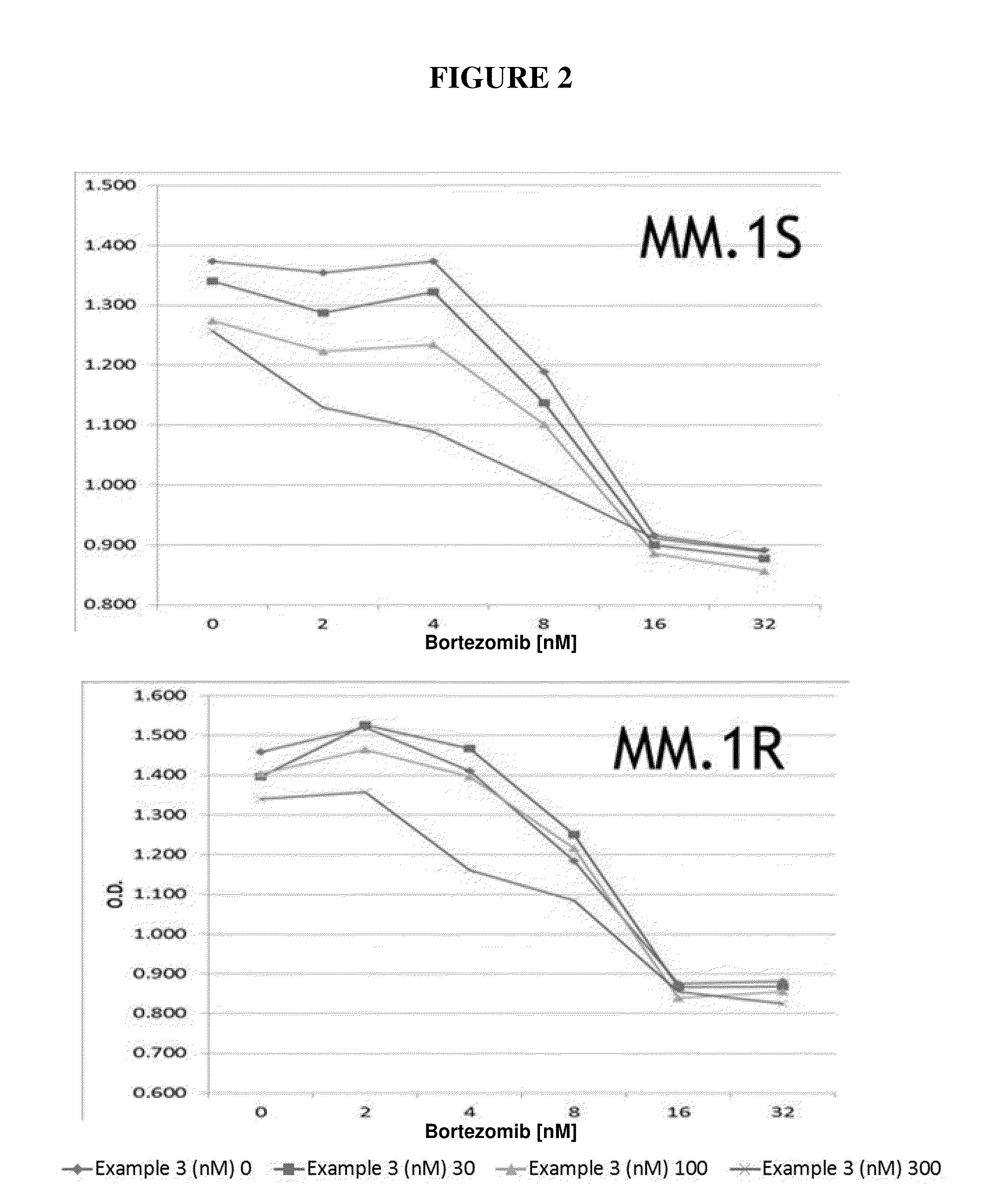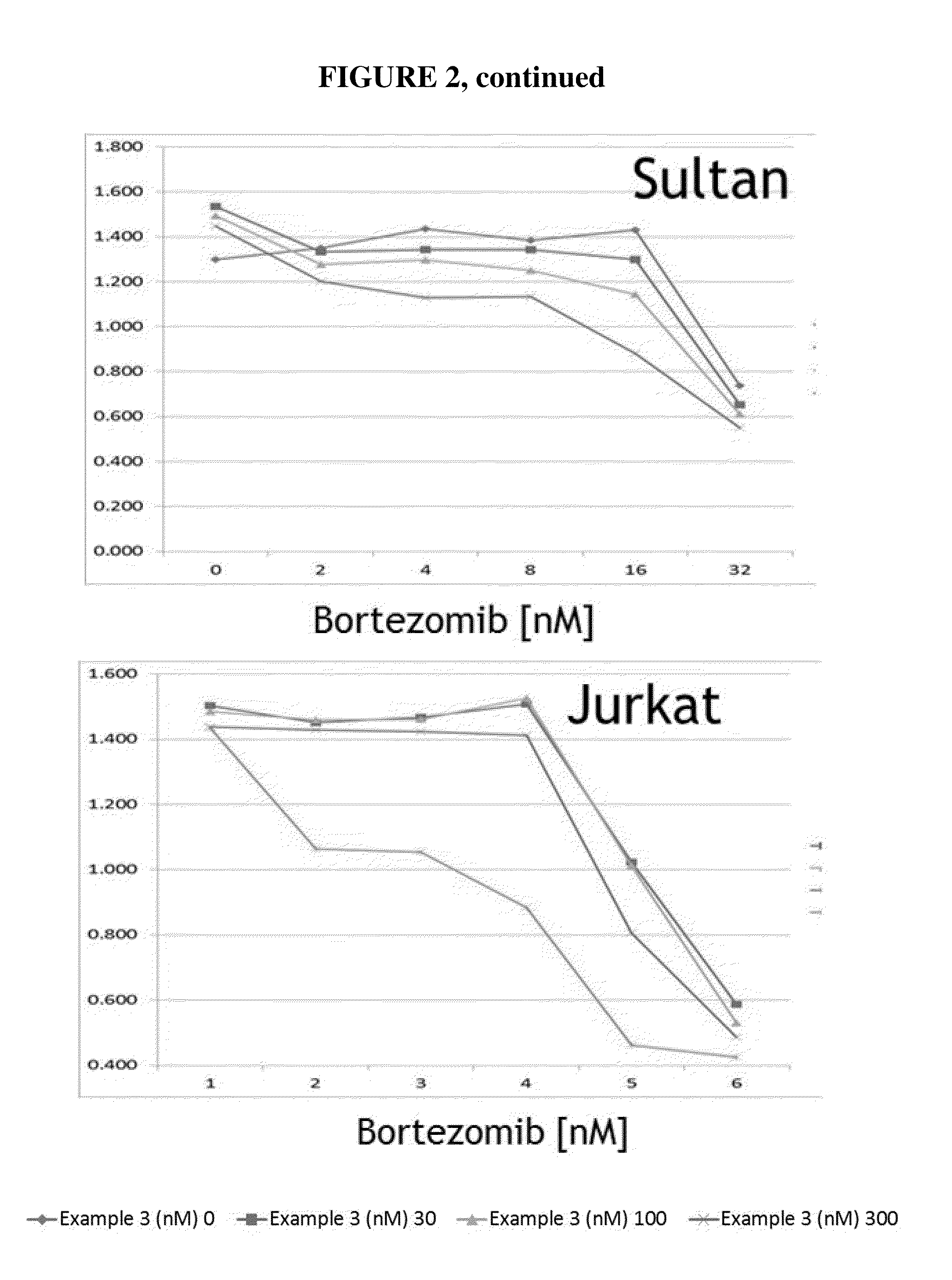Nuclear transport modulators and uses thereof
a technology of nuclear transport and modulators, applied in the field of compounds, can solve the problems of loss of normal growth regulation, loss of suppressor function, poor clinical outcomes of these tumor types,
- Summary
- Abstract
- Description
- Claims
- Application Information
AI Technical Summary
Benefits of technology
Problems solved by technology
Method used
Image
Examples
example 1
[0344]
Synthesis of Intermediate (1)
[0345]
[0346]In a 3-neck 2 L round-bottomed flask, equipped with an overhead mechanical stirrer, slurry of sodium hydrosulfide hydrate (90.9 g, 1.226 mmol) and magnesium chloride hexahydrate (125.86 g, 0.620 mmol) in 1 L of DMF was added 3-Chlorobenzonitrile (85 g, 0.620 mmol) in one portion, and the reaction mixture was stirred at room temperature for 2 h. The progress of reaction was followed by TLC analysis on silica gel using ethyl acetate:hexane (1:1) as mobile phase. The resulting green slurry was poured in 5000 mL water, and the resulting precipitates were collected by filtration. The crude product was re-suspended in 1 N HCl and stirred for 45 min, then filtered and washed with water to give intermediate-1 (63 g, 75%). Mass / LCMS: 180.0; NMR confirmed.
Synthesis of Intermediate (2)
[0347]
[0348]In a 3-neck 2 L round-bottomed flask, equipped with an overhead mechanical stirrer, a solution of intermediate-1 (50.0 g, 0.292 mmol) in 750 mL diethyl e...
example 2
[0353]
Synthesis of Intermediate (1)
[0354]
[0355]In 3-neck 50 mL round-bottomed flask, 4-chlorobenzonitrile (5.0, 1 eq.) was mixed with formic acid (25 mL, 5 Vol) and hydrazine hydrate (25 mL, 5 Vol) and reaction mixture was refluxed to 110° C. for 12 h. Reaction was clear solution once it attained 90° C. Reaction remained yellow colored clear solution throughout the reaction. Reaction completion was monitored on TLC using ethyl acetate:hexane (4:6) mobile phase. After 12 h reaction was completed and worked up. Reaction mixture was brought to room temperature and quenched into the ice-water slurry (100 mL) and compound was extracted in the ethylacetate (50 mL×3). Organic layer was washed with brine solution (50 mL×3) followed by drying using anhydrous sodium sulphate. Organic layer was concentrated under reduced pressure to afford 5.5 g of crude compound. Crude compound was further purified by column chromatography using silica 60 / 120 and ethylacetate:hexane as mobile phase. Column pu...
example 3
Synthesis of Example 3
[0357]
[0358]In 3-neck 50 mL round-bottomed flask, Intermediate-1 (0.4 g, 1.0 eq.) was dissolved in DCM (10 mL, 25 Vol), added isopropyl propiolate (0.35 g, 1.4 eq) and TEA (0.334 g, 1.5 eq) and reaction mixture was stirred at RT for 30 mins. Reaction completion was monitored on TLC using ethyl acetate:hexane (2:8) mobile phase. After 30 mins reaction mixture was concentrated under reduced pressure to afford 0.6 g of crude compound. Compound was further purified by column chromatography using silica 60 / 120 and ethylacetate:hexane as mobile phase. Column purification was started with 5% EtOAc in hexane upto 20%. Compound started eluting in 11% ethylacetate and continued till 15% EtOAc. Fractions containing compound was distilled out using rotary evaporation at 45° C. / 250 mm Hg to obtain 0.021 g of pure compound. HPLC / LCMS: 99.58%; Mass / LCMS: 292.2; 1H NMR (400 MHz, CDCl3) δ=8.36 (s, 1H), 8.11 (s, 1H), 7.99-8.01 (d, J=8 Hz, 1H), 7.44-7.46 (d, J=8 Hz, 2H), 7.22-7.2...
PUM
 Login to View More
Login to View More Abstract
Description
Claims
Application Information
 Login to View More
Login to View More - R&D
- Intellectual Property
- Life Sciences
- Materials
- Tech Scout
- Unparalleled Data Quality
- Higher Quality Content
- 60% Fewer Hallucinations
Browse by: Latest US Patents, China's latest patents, Technical Efficacy Thesaurus, Application Domain, Technology Topic, Popular Technical Reports.
© 2025 PatSnap. All rights reserved.Legal|Privacy policy|Modern Slavery Act Transparency Statement|Sitemap|About US| Contact US: help@patsnap.com



